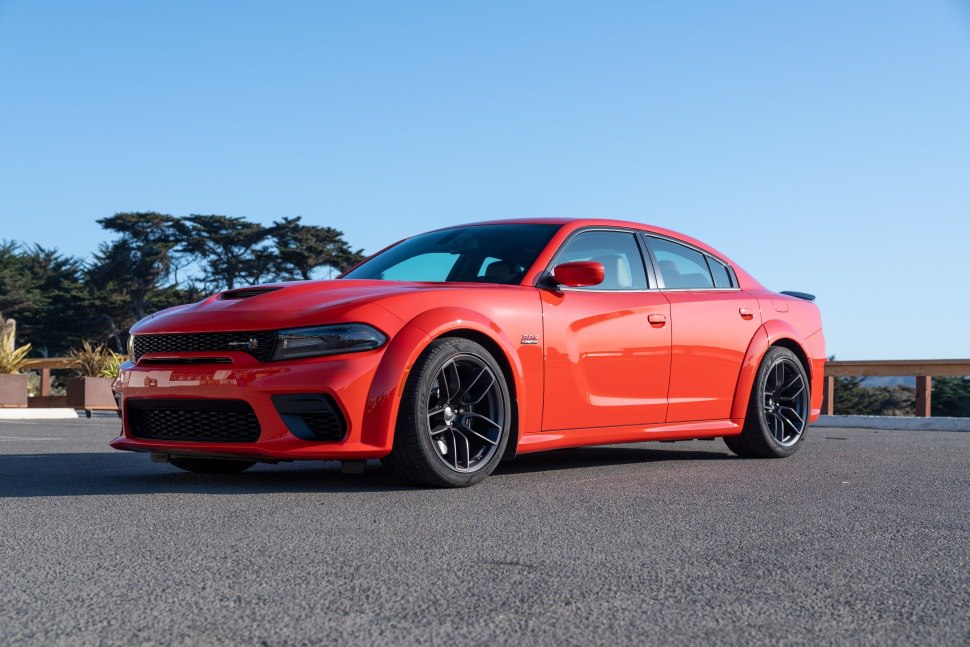2019 Dodge Charger VII (LD, facelift 2019) GT 3.6 Pentastar V6 (300 Hp) AWD Automatic | Specifications







































| Assisting systems | ABS (Anti-lock braking system) |
| Drive wheel | All wheel drive (4x4) |
| Front brakes | Ventilated discs, 345 mm |
| Front suspension | Wishbone, Transverse stabilizer |
| Number of gears and type of gearbox | 8 gears, automatic transmission |
| Power steering | Electric Steering |
| Rear brakes | Ventilated discs, 320 mm |
| Rear suspension | Independent multi-link suspension |
| Steering type | Steering rack and pinion |
| Tires size | 235/55 R19 |
| Wheel rims size | 7.5J x 19 |
Dimensions
| Drag coefficient (Cd) | 0.335 |
| Front track | 1607 mm |
| Height | 1485 mm |
| Length | 5100 mm |
| Minimum turning circle (turning diameter) | 11.8 m |
| Rear (Back) track | 1611 mm |
| Ride height (ground clearance) | 131 mm |
| Wheelbase | 3048 mm |
| Width | 1905 mm |
| Width including mirrors | 2100 mm |
Engine specs
| Compression ratio | 10.2:1 |
| Coolant | 9.5 l |
| Cylinder Bore | 96 mm |
| Engine Model/Code | ERB |
| Engine aspiration | Naturally aspirated engine |
| Engine configuration | V-engine |
| Engine displacement | 3604 cm3 |
| Engine layout | Front, Longitudinal |
| Engine oil capacity | 5.6 l |
| Fuel injection system | Multi-port manifold injection |
| Maximum engine speed | 6400 rpm. |
| Number of cylinders | 6 |
| Number of valves per cylinder | 4 |
| Piston Stroke | 83 mm |
| Power | 300 Hp @ 6350 rpm. |
| Power per litre | 83.2 Hp/l |
| Torque | 358 Nm @ 4800 rpm. |
| Valvetrain | DOHC |
General information
| Body type | Sedan |
| Brand | Dodge |
| Doors | 4 |
| End of production | December, 2023 year |
| Generation | Charger VII (LD, facelift 2019) |
| Model | Charger |
| Modification (Engine) | GT 3.6 Pentastar V6 (300 Hp) AWD Automatic |
| Powertrain Architecture | Internal Combustion engine |
| Seats | 5 |
| Start of production | 2019 year |
Space, Volume and weights
| Fuel tank capacity | 70 l |
| Kerb Weight | 1920 kg |
| Permitted trailer load without brakes | 454 kg |
| Trunk (boot) space - minimum | 467 l |
Performance specs
| Fuel Type | Petrol (Gasoline) |
| Fuel consumption (economy) - combined | 11.2 l/100 km |
| Fuel consumption (economy) - extra urban | 8.7 l/100 km |
| Fuel consumption (economy) - urban | 13.1 l/100 km |
| Weight-to-power ratio | 6.4 kg/Hp, 156.3 Hp/tonne |
| Weight-to-torque ratio | 5.4 kg/Nm, 186.5 Nm/tonne |
Frequently Asked Questions
Here are answers to some common questions
The VIN number, also known as the VIN code, is the vehicle identification number. VIN is an abbreviation of the English term Vehicle Identification Number. The VIN number is a unique set of 17 characters that car manufacturers assign to all vehicles they produce. The VIN code can be found on various parts of the car body or in the registration documents.
In the CarVertical vehicle report, you will find the most important information about the vehicle that will allow you to assess the condition of the vehicle. In the report, you will find information such as vehicle mileage, accident data, countries of previous registrations, records from searched car databases, and much more useful information.
CarVertical reports are available immediately or can take up to a few minutes. The service is provided 24 hours a day, 7 days a week, reports are generated automatically. It basically takes as long as it takes to process your payment - the sooner the money reaches your CarVertical account, the sooner you will receive a report.
First of all, CarVertical is generally the world's first provider of VIN history reports by car code, receiving some of the data in real-time directly from the car. The information obtained in this way is the most up-to-date, which is why it is so operative. In addition, CarVertical uses BlockChain technology, so the data available to CarVertical is genuine and real.
Information about cars is obtained from many sources, including car services, national registers of various countries, insurance companies, "connected" car parks, and so on.
